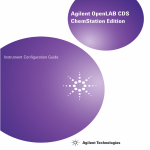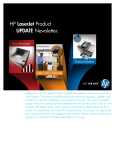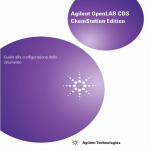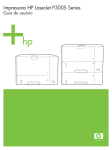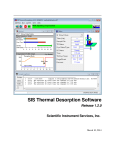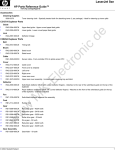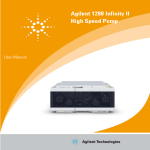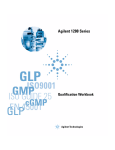Download Agilent ChemStation for GC Systems Data Analysis
Transcript
Agilent ChemStation for GC Systems, Data Analysis, and 35900E A/D Converter Installing Your ChemStation Agilent Technologies Notices © Agilent Technologies, Inc. 2009 Warranty No part of this manual may be reproduced in any form or by any means (including electronic storage and retrieval or translation into a foreign language) without prior agreement and written consent from Agilent Technologies, Inc. as governed by United States and international copyright laws. The material contained in this document is provided “as is,” and is subject to being changed, without notice, in future editions. Further, to the maximum extent permitted by applicable law, Agilent disclaims all warranties, either express or implied, with regard to this manual and any information contained herein, including but not limited to the implied warranties of merchantability and fitness for a particular purpose. Agilent shall not be liable for errors or for incidental or consequential damages in connection with the furnishing, use, or performance of this document or of any information contained herein. Should Agilent and the user have a separate written agreement with warranty terms covering the material in this document that conflict with these terms, the warranty terms in the separate agreement shall control. Manual Part Number G2070-91028 Edition First edition, July 2009 Replaces G2070-91027 Printed in USA Agilent Technologies, Inc. 2850 Centerville Road Wilmington, DE 19808-1610 USA Acknowledgements Microsoft® and Windows® are registered trademarks of the Microsoft Corporation. PostScript® is a trademark of Adobe Systems Incorporated. Safety Notices CAUTION A CAUTION notice denotes a hazard. It calls attention to an operating procedure, practice, or the like that, if not correctly performed or adhered to, could result in damage to the product or loss of important data. Do not proceed beyond a CAUTION notice until the indicated conditions are fully understood and met. Technology Licenses The hardware and/or software described in this document are furnished under a license and may be used or copied only in accordance with the terms of such license. Restricted Rights If software is for use in the performance of a U.S. Government prime contract or subcontract, Software is delivered and licensed as “Commercial computer software” as defined in DFAR 252.227-7014 (June 1995), or as a “commercial item” as defined in FAR 2.101(a) or as “Restricted computer software” as defined in FAR 52.227-19 (June 1987) or any equivalent agency regulation or contract clause. Use, duplication or disclosure of Software is subject to Agilent Technologies’ standard commercial license terms, and non-DOD Departments and Agencies of the U.S. 2 Government will receive no greater than Restricted Rights as defined in FAR 52.227-19(c)(1-2) (June 1987). U.S. Government users will receive no greater than Limited Rights as defined in FAR 52.227-14 (June 1987) or DFAR 252.227-7015 (b)(2) (November 1995), as applicable in any technical data. WA R N I N G A WARNING notice denotes a hazard. It calls attention to an operating procedure, practice, or the like that, if not correctly performed or adhered to, could result in personal injury or death. Do not proceed beyond a WARNING notice until the indicated conditions are fully understood and met. Installing Your ChemStation In This Manual... This manual describes how to install the ChemStation software, how to add additional instrument modules to an existing system, how to configure your analytical system, and how to verify that the installation and configuration are complete and operational. Chapters included in this manual are: 1 - Installation Preparation - This chapter gives an overview of the Agilent Technologies ChemStation. It lists PC requirements, upgrade requirements, and instrument communications information. 2 - Installing the Agilent ChemStation - This chapter gives procedures for installing and upgrading the Agilent ChemStation software. 3 - Configuring the Instruments - This chapter describes how to use the Configuration Editor to configure your instruments. 4 - Validating and Starting the Agilent ChemStation - This chapter describes how to validate and begin using the Agilent ChemStation software. 5 - Additional Resources - This chapter provides an overview of the additional Agilent ChemStation resources found on the Agilent ChemStation DVD and the World Wide Web. This manual assumes: • You are familiar with the use of Microsoft® Windows XP Professional or Microsoft® Windows Vista™ Business operating system. • You will be installing the software on a PC meeting the minimum hardware requirements. • Your instruments and communication devices are compatible with this version of the Agilent ChemStation. The Agilent ChemStation software communicates with analytical equipment via Local Area Network (LAN) or General Purpose Interface Bus (GPIB) data communications. 3 Installing Your ChemStation 4 Installing Your ChemStation Contents 1 Installation Preparation PC Requirements About LAN 8 11 Instrument Communications Setting IP Addresses at the GC Installing Agilent BootP Service 12 14 17 Installing and Configuring the Agilent GPIB Interface Board 2 Installing the Agilent ChemStation Before You Begin 28 Installation Procedures 29 Adding an instrument to an existing installation Installing the Control Charts Reports 3 25 35 36 Configuring the Instruments About the Agilent ChemStation Configuration Editor 38 Configuring the Agilent ChemStation for GC Systems (7890A, 6890, 6850, and 5890/4890) 39 Configuring the Agilent ChemStation for Data Analysis Systems 43 Configuring the Agilent ChemStation for 35900E A/D Interface Systems 45 Modifying Method, Sequence, and Data File Paths Installing Your ChemStation 51 5 4 Validating and Starting the Agilent ChemStation Installation Qualification Report Application 54 Operation Qualification/Performance Verification (OQ/PV) 5 58 Additional Resources Agilent Technologies Customer Contact Center Contents of the Agilent ChemStation DVD Learning Products 62 64 Agilent ChemStation Help system Agilent Lab Advisor Software More information 60 65 66 66 Index 6 Installing Your ChemStation Agilent ChemStation for GC Systems, Data Analysis, and 35900E A/D Converter Installing Your ChemStation 1 Installation Preparation PC Requirements 8 About LAN 11 Instrument Communications 12 Setting IP Addresses at the GC 14 Configuring the IP address for the Agilent 7890A GC 14 Configuring the IP address for the Agilent 6890N GC 15 Configuring the IP address for the Agilent 6850 GC 16 Installing Agilent BootP Service 17 Installing and Configuring the Agilent GPIB Interface Board 25 This chapter gives an overview of the Agilent Technologies ChemStation. It lists PC requirements, upgrade requirements, and instrument communications information. Agilent Technologies 7 1 Installation Preparation PC Requirements Minimum hardware requirements for your Agilent Technologies ChemStation software (version B.04.02) are: • A personal computer with an Intel Pentium IV processor (1.5 GHz for Microsoft Windows XP Professional) (3.4 GHz [single core] for Microsoft Windows Vista) • 1280 × 1024 Super VGA resolution display, 16k colors or better • 40 GB hard disk (Microsoft Windows XP Professional), 160 GB hard disk (Microsoft Windows Vista) • DVD drive • 512 MB RAM (Microsoft Windows XP Professional), 1 GB (Microsoft Windows Vista) • Pointing device compatible with Microsoft Windows • Operating system compatible printer. For the English system using PCL 5c, 5e, 5e, 5.02 or 6, for a Chinese system using PCL 6, and for a Japanese system please check Table 1. • A Microsoft Windows XP Professional (Service Pack 3) or Microsoft Windows Vista Business (Service Pack 1) operating environment (English, Chinese, and Japanese only). • TCP/IP protocol support installed if you are using LAN communications • For GPIB communications use either the 82357B USB GPIB adapter or the 82350B PCI GPIB card, and the I/O Library Suite 15.0. Refer to the Manuals directory of the ChemStation DVD for Agilent I/O Library Suite installation instructions. All PC hardware and peripherals must be listed in the Microsoft Hardware Compatibility List (HCL), which is available on the Microsoft home page at http://www.microsoft.com. If your PC hardware is not in the HCL, the system may not work correctly with the Agilent ChemStation software. Non-HP computers The Agilent ChemStation is designed to successfully run on a wide range of compatible personal computers equipped with accessories and peripherals that adhere to the programming standards for the Intel PC platform and Microsoft Windows operating systems. 8 Installing Your ChemStation Installation Preparation 1 However, Agilent has tested the Agilent ChemStation software mainly on Hewlett- Packard (HP)/Compaq equipment. The standard configuration of the GPIB interface, for instance, may conflict with the memory configuration of a non- HP computer. Additional accessory interface boards may cause conflicts with hardware- related resources (such as I/O ports, interrupt settings, and DMA channels). For a non- HP computer, use the setup utility program supplied by the manufacturer to configure your computer. Check the documentation supplied with your computer and the accessories to eliminate resource conflicts in your PC’s setup, especially regarding the configuration of the GPIB interface. Printers for the Agilent ChemStation The Agilent ChemStation is designed to work with printers that are compatible with the operating system. Printers may be attached to a local (preferably parallel) or networked port on the PC. Serial port printers are supported by the operating system but may exhibit speed performance limitations. Networked printers must be shared by a network server running a network protocol supported by the Microsoft operating system. We recommend printers that are capable of interpreting an escape code language (such as PCL) or page description language (such as PostScript®). Host- based printers (such as Graphical Device Interface [GDI] or Printer Performance Architecture [PPA] printers) impose more printer processing tasks on the CPU and are not recommended for use with Agilent ChemStation online sessions. For the best printing results with your Agilent ChemStation software, use HP LaserJet printers (see Table 1). High- performance HP DeskJet printers may also be used if the amount of printing required is low. Check the readme.txt files for information on recommended printer driver versions. Agilent has not tested all printer and printer driver combinations that are supported in the Windows environment. Print performance and results may vary on other manufacturers’ printers. Installing Your ChemStation 9 1 Installation Preparation Table 1 10 Printers successfully tested with Agilent ChemStation B.04.02 Printer Model Driver HP LaserJet 4050 and 4100 HP PCL 5e or PCL 6 driver HP LaserJet 4200 HP PCL 5e or PCL 6 driver HP LaserJet 4250 HP PCL 6 driver HP LaserJet P3005D HP PCL 6 driver HP Color LaserJet 2500TN HP PCL 6 driver HP OfficeJet Pro K550DTWN HP PCL 3 driver HP OfficeJet Pro K5400 HP LaserJet 2200D HP PCL 5.02 or PCL 6 driver HP LaserJet 2300DN HP PCL 5e or PCL 6 driver HP LaserJet 2420D HP PCL 6 driver Installing Your ChemStation 1 Installation Preparation About LAN The Agilent ChemStation software uses the TCP/IP protocol, which needs to be installed as a network protocol on your PC. If you are controlling an Agilent 6890 Plus, 6890A, or 35900E, the J4100A JetDirect and G1369A LAN cards used to connect those analytical instruments to a LAN require the Bootstrap Protocol (BootP). Agilent supports only the Agilent BootP Service, provided on the ChemStation DVD, for this use. Version B.04.02 of the Agilent ChemStation software provides LAN- based instrument control and data acquisition for LAN- capable Agilent GCs and A/D controllers. You can easily control and monitor instruments by connecting them to a LAN on which the Agilent ChemStation PC resides. This allows the Agilent ChemStation PC to be located up to 100 meters from instruments it controls on an Agilent- supported standalone LAN, or anywhere in the world on a TCP/IP- based network supported by your network administrator. Each Agilent ChemStation can support up to four instruments on the LAN. Each device on the LAN requires a unique IP address, a subnet mask, and a default gateway. If you are installing Agilent ChemStation on a site LAN, contact the site LAN administrator. The Agilent ChemStation supports instruments and PCs with self- assigned fixed addresses or addresses assigned by the Agilent BootP Service (see “Installing Agilent BootP Service” on page 17). DHCP is not supported by Agilent. Installing Your ChemStation 11 1 Installation Preparation Instrument Communications The Agilent ChemStation communicates to the GCs through either a LAN or a GPIB communication interface. Be sure to set up the communication channel between the instrument and the PC prior to operating the system. For details on installing a LAN board in your PC or in any instrument the Agilent ChemStation will control, refer to the documentation accompanying the LAN board. LAN communications Refer to the page number listed in Table 2 for details on setting up the required communications hardware and software for your specific system. Table 2 12 LAN communication interfaces supported by the Agilent ChemStation Supported IP addressing method Refer to: Instrument type Model Supported firmware revision 7890A G3440A A.01.10.1 Set at GC page 14 6890N GC G1530N/ G1540N N.06.05 for 7693A, or N.05.06 (LAN assembly 04.7B3) Set at GC page 15 6890 Plus, 6890A G1530A/ G1540A A.03.08 Agilent BootP Service page 20 6850 GC SN ≥ US10243001 G2630A N.06.03 for 7693A, or A.05.04 (LAN assembly 04.7B3) Set at GC page 16 6850 GC SN ≤ US00003200 G2630A A.03.05 for 7693A, or A.03.03 Set at GC, or Agilent BootP Service page 16 page 20 35900E 35900E E.01.02 Agilent BootP Service page 20 Installing Your ChemStation Installation Preparation 1 GPIB communication Analytical instruments that communicate with the Agilent ChemStation via GPIB require a GPIB board to be installed in your computer. Refer to Table 3 for a list of instrument types that use GPIB communication along with the supported 82350B interface board and the 82357B USB- GPIB Interface. Table 3 GPIB and analytical hardware compatibility Instrument type Model Supported firmware revision Agilent 82357B Agilent 82350B 6890 Plus, 6890A G1530A/ G1540A A.03.08 Yes Yes 5890 Series II 5890 A.03.02 Yes Yes 4890D G2690A A.01.01 Yes Yes 7890A No No 6850 No No 6890N No No 35900E No No See “Installing and Configuring the Agilent GPIB Interface Board” on page 25 for details on GPIB hardware setup. For details on installing and setting up the Agilent IO Libraries Suite 15.0, see the installation and configuration instructions found on the ChemStation DVD in the Support\ Manuals\Installation folder. Installing Your ChemStation 13 1 Installation Preparation Setting IP Addresses at the GC This section describes how to use a GC's keypad to set its IP address. For GCs that do not support this feature, see “Installing Agilent BootP Service” on page 17. Configuring the IP address for the Agilent 7890A GC This procedure refers to the Agilent 7890A GC. 1 On the 7890A keyboard, press Options. Scroll to Communication and press Enter. This screen appears: COMMUNICATION SETPTS ---- LAN ---IP: 000.000.000.000 GW: 000.000.000.000 SM: 000.000.000.000 Enable DHCP OFF Reboot GC Mac Address 2 Enter the numbers of the 7890A GC’s IP address, separated by periods, and press Enter.* The GC displays a message instructing you to power cycle the instrument. Do not power cycle yet. Press Clear. 3 Scroll to GW. Enter the gateway number and press Enter. The 7890A displays a message instructing you to power cycle the instrument. Do not power cycle yet. Press Clear. 4 Scroll to SM and press Mode/Type. Scroll to the appropriate subnet mask from the list of modes and press Enter. The 7890A displays a message instructing you to power cycle the instrument. Do not power cycle yet. 5 Scroll to Reboot GC and press On/Yes to power cycle the instrument and apply the LAN setpoints to the board. 6 Press Options. Scroll to Communications and press Enter. Confirm that the correct setpoints are present. * If you do not know the IP address, gateway, or subnet mask settings for your Agilent ChemStation computer, Agilent recommends setting the default PC IP address to 10.1.1.100, the GC or A/D control module to 10.1.1.101 through 10.1.1.105, the default gateway to 10.1.1.100, and the default subnet mask to 255.255.255.0. 14 Installing Your ChemStation Installation Preparation 1 Configuring the IP address for the Agilent 6890N GC This procedure refers to the Agilent 6890N GC (with LAN assembly). 1 On the 6890N keyboard, press Options. Scroll to Communication and press Enter. This screen appears: COMMUNICATION SETPTS ---- LAN ---IP: 000.000.000.000 GW: 000.000.000.000 SM: 000.000.000.000 Enable DHCP OFF ---- RS-232 ---2 Enter the IP address for your 6890N. Enter the numbers separated by periods and press Enter.* The GC displays a message instructing you to power cycle the instrument. Do not power cycle yet. Press Clear. 3 Scroll to GW. Enter the gateway number and press Enter. The 6890N displays a message instructing you to power cycle the instrument. Do not power cycle yet. Press Clear. 4 Scroll to SM and press Mode/Type. Scroll to the appropriate subnet mask from the list of modes and press Enter. The 6890N displays a message instructing you to power cycle the instrument. 5 Power cycle the instrument to apply the LAN setpoints to the board. 6 Press Options. Scroll to Communications and press Enter. Confirm that the correct setpoints are present. * If you do not know the IP address, gateway, or subnet mask settings for your Agilent ChemStation computer, Agilent recommends setting the default PC IP address to 10.1.1.100, the GC or A/D control module to 10.1.1.101 through 10.1.1.105, the default gateway to 10.1.1.100, and the default subnet mask to 255.255.255.0. Installing Your ChemStation 15 1 Installation Preparation Configuring the IP address for the Agilent 6850 GC This procedure refers to the 6850 Series GC (with LAN assembly). 1 Turn the GC off. 2 Press and hold LOAD and turn the GC on. Continue to hold LOAD until five periods appear in the display. 3 When the GC starts, you should see: DHCP MODE: DISABLED If the DHCP MODE is not set to DISABLED, press ▲ or ▼ to change the mode to DISABLED. Press LOAD to continue to the next item. 4 The display will now read: IP ADDRESS XXX.XXX.XXX.XXX 5 Press LOAD to adjust the IP ADDRESS values. Press ▲ or ▼ to change values and LOAD to move from one value to the next.* 6 When IP ADDRESS is completed, the display reads: DEFAULT GATEWAY XXX.XXX.XXX.XXX 7 Change the DEFAULT GATEWAY as you did the IP ADDRESS.* 8 Change the SUBNET MASK value in the same manner.* 9 Cycle the GC power for new settings to take effect. * If you do not know the IP address, gateway, or subnet mask settings for your Agilent ChemStation computer, Agilent recommends setting the default PC IP address to 10.1.1.100, the GC or A/D control module to 10.1.1.101 through 10.1.1.105, the default gateway to 10.1.1.100, and the default subnet mask to 255.255.255.0. 16 Installing Your ChemStation 1 Installation Preparation Installing Agilent BootP Service The J4100A JetDirect and G1369A LAN cards used to connect an analytical instrument to a LAN require the Bootstrap Protocol. Agilent supports only the Agilent BootP Service, provided on the ChemStation DVD, for this use. This section describes how to install the Agilent BootP Service software. The Agilent BootP Service will assign addresses to any device that does not have the ability to set its own address. Purpose The Agilent BootP Service provides central administration of IP addresses for Agilent instruments on a LAN. The service runs on the instrument LAN PC, which must be running TCP/IP network protocol and cannot run a DHCP server. When an instrument is powered on, an Agilent JetDirect card in the instrument broadcasts a request for an IP address or host name and provides its hardware address as an identifier. The request may continue for up to 5 minutes. The Agilent BootP Service answers this request and passes a previously defined IP address and host name associated with the hardware address to the requesting instrument. When the instrument receives its IP address and host name, it stops broadcasting the request. It maintains the IP address as long as it is powered on. Powering down the instrument causes it to lose its IP address, so the Agilent BootP Service must be started every time the instrument powers up. Since the Agilent BootP Service runs in the background, the instrument will receive its IP address on power- up. Addresses Before installing and configuring the Agilent BootP Service, you must know the IP addresses of the computer and instruments, the subnet mask, and the gateway (see Chapter 1). Installing Your ChemStation 17 1 Installation Preparation Installation Follow this procedure to install the Agilent BootP Service. 1 Log on as Administrator or other user with Administrator privileges. 2 Close all Windows programs. NOTE If you are using LAN communication or moving from a GPIB to a LAN connection, you must use the Agilent BootP Service with ChemStation (Rev. B.04.02) to provide IP addresses to instruments that cannot set their own IP addresses. CAG BootP Server is not supported. Prior to installing the Agilent BootP Service Program, remove CAG BootP Server from your computer. 3 Insert the Agilent ChemStation software DVD into the drive. If the setup program starts automatically, click Cancel to stop it. 4 Open Windows Explorer. 5 Double- click BootPPackage.msi in the BootP directory of the Agilent ChemStation software DVD. 6 If necessary, click the Agilent BootP Service... icon in the task bar. 7 The Welcome screen appears. Click Next >. 8 The License Agreement screen appears. Read it, indicate acceptance, then click Yes. 9 Click Install. 18 Installing Your ChemStation Installation Preparation 1 10 Files load; when finished, the BootP Settings screen appears. • The BootP Settings screen contains unconfigured default settings. These settings will be entered during the configuration procedure. • Use the IPCONFIG utility to verify the TCP/IP settings by opening a command window and typing ipconfig/all. 11 Select the Do you want to log BootP requests? check box. The Do you want to log BootP requests? box must be cleared when you have finished configuring instruments; otherwise, the logfile will quickly fill up disk space. 12 In the Default Settings part of the screen, enter the subnet mask and gateway. See your network administrator if you do not know the subnet mask and gateway. • The default subnet mask is 255.255.255.0. • The default gateway is 10.1.1.101. 13 Click OK. The Agilent BootP Service Setup screen appears. 14 Click Finish to exit the Agilent BootP Service Setup screen. 15 Remove the DVD from the drive. This completes installation. Installing Your ChemStation 19 1 Installation Preparation The Agilent BootP Service README is available for printing. It can be accessed from C:\Program Files\Common Files\Agilent Shared\BootP\bin\ Readme.htm. Assigning IP addresses to instruments using the Agilent BootP Service The Agilent BootP Service maintains an association between a unique identification code (MAC address) provided with the LAN card installed in a given instrument and the specific IP address assigned to that instrument. Therefore, you must define or redefine this association whenever you add a new instrument, exchange an instrument (or its LAN card), or change the IP address assigned to an instrument. Configuring instruments using the Agilent BootP Service 1 Determine the MAC address of the GC with the JetDirect card installed using either: • The Agilent BootP Service (see step 2) • A JetDirect card (see step 3) 2 To use the Agilent BootP Service to determine the MAC address of the GC: a Power cycle the GC. b After the GC completes its self- test, open the logfile using Notepad. • The default location for the logfile is My Computer\Local Disk\ Program Files\Common Files\Agilent Shared\BootP\bin\logfile. • The logfile will not be updated if it is open. • Assign an address only to devices that cannot set their own address. See the instrument’s operating documentation for more information. The contents will be similar to the following: 20 Installing Your ChemStation Installation Preparation 1 02/25/04 15:30:49 PM Status: BootP Request received at outermost layer Status: BootP Request received from hardware address: 0010835675AC Error: Hardware address not found in BootPTAB: 0010835675AC Status: BootP Request finished processing at outermost layer c Record the MAC address (for example, 0010835675AC), also referred to as the hardware address. d Close the logfile before turning on another instrument. e Skip to step 4. 3 To use a JetDirect card to determine the MAC address of the GC: a Turn off the instrument. b Remove the JetDirect card. c Read the MAC address from the label. The MAC address is printed on a label on the noncomponent side of the JetDirect card. It is the number below the barcode and after the colon (:) and usually begins with the letters AD. d Reinstall the card. e Turn on the GC. 4 Add the GC instrument to the network. a Follow Start > All Programs > Agilent BootP Service and select Edit BootP Settings. The BootP Settings screen appears. b Clear Do you want to log BootP requests? The Do you want to log BootP requests? box must be cleared when you have finished configuring instruments; otherwise, the logfile will quickly fill up disk space. c Click Edit BootP Addresses... d Click Add... The Add BootP Entry screen appears. Installing Your ChemStation 21 1 Installation Preparation e Make these entries for the GC: • MAC address • Host name • IP address • Comment, if desired • Subnet mask • Gateway address f Click OK. g Exit BootP Manager and power cycle the GC. If you are changing the IP address, power cycle the instrument for the changes to take effect. h Ping the IP address to verify. 5 Add an additional instrument or device to the network. a Repeat step 4 for each instrument or device on the network that requires the BootP Service. b When you are finished, click Close. c Click OK. 22 Installing Your ChemStation Installation Preparation 1 Configuring the Agilent BootP Service Agilent BootP Service starts automatically when your PC reboots. To change Agilent BootP Service settings, you must stop the service, make the changes, and then restart the service. Follow the procedures below to configure your Agilent BootP Service. Stopping the Agilent BootP Service 1 From the Windows control panel, select Administrative Tools > Services. The Services screen appears. 2 Right- click Agilent BootP Service. 3 Select Stop. 4 Close the Services and Administrative Tools screen. Editing the settings 1 Select Start > All Programs > Agilent BootP Service and select Edit BootP Settings. The BootP Settings screen appears. Installing Your ChemStation 23 1 Installation Preparation 2 When the BootP Settings screen is first opened, it shows the default settings from installation. Creating the TabFile To create a new template for the TabFile, select Create Tab File. A default TabFile was created at installation and is located at C:\Program Files\Common Files\Agilent Shared\BootP\bin\TabFile. It contains configuration information entered on this screen. Configuring the logfile Select the Do you want to log bootP requests? box to capture all requests made to the GC, to capture the MAC address. Clear the Do you want to log bootP requests? box after configuring instruments to avoid having the logfile from using up excessive disk space. A default log file was created at installation and is located at C:\Program Files\Common Files\Agilent Shared\BootP\bin\logfile. It contains an entry for every time a device requests configuration information from BootP. Restarting the Agilent BootP Service 1 In the Windows control panel, select Administrative Tools > Services. The Services screen appears. 2 Right- click Agilent BootP Service and select Start. 3 Close the Services and Administrative Tools screens. This completes configuration. 24 Installing Your ChemStation 1 Installation Preparation Installing and Configuring the Agilent GPIB Interface Board If you are not using GPIB communications, skip this section. Installing and configuring the GPIB interface board To install the GPIB interface board, refer to your computer manual or follow these instructions. WA R N I N G Disconnect your computer and all attached electrical devices before removing any covers. Be sure to wear an antistatic strap when installing the GPIB board. 1 Turn off and unplug your computer, then remove the computer’s cover(s). 2 Select any empty slot to install your GPIB board. The GPIB cable may experience interference if the board is placed in the last slot in the PC cabinet. 3 Loosen the mounting screw and remove the selected empty slot’s rear plate. 4 Holding the board by its edges, insert it into its slot. Make certain that the board’s edge connector is fully seated. Lock the board into place with the mounting screw. 5 Replace the computer’s cover(s). Plug in and restart the computer. 6 After you have installed the GPIB board in the computer, you need to install the corresponding driver and configuration software located on the Agilent ChemStation DVD in the Agilent I/O Library Suite directory. Refer to the Agilent I/O Library Suite installation guide, found on the ChemStation DVD in the Support\Manuals\Installation folder. Installing Your ChemStation 25 1 Installation Preparation GPIB cabling When connecting GPIB devices together, observe these rules: • Whenever possible, turn off and unplug the computer and all attached devices before the GPIB cables are installed. • Before connecting any analytical instrument to a GPIB cable, consult the documentation supplied with each device and determine its GPIB address. No two devices connected to the Agilent ChemStation may have the same address. Write down each GPIB address. This information will be needed later. • Where possible, use GPIB cables that are two meters long or less. Cable (0.5 m) (part no. 10833D) Cable (1.0 m) (part no. 10833A) Cable (2.0 m) (part no. 10833B) Cable (4.0 m) (part no. 10833C) CAUTION The Agilent ChemStation does not support GPIB extenders. • Connect one end of a GPIB cable to the computer’s GPIB connector. Be certain that you properly tighten all GPIB connectors. A poor connection causes errors that are difficult to diagnose. • Connect GPIB devices in a “chain.” A chain occurs when a GPIB device is connected to the next GPIB device, and it is, in turn, connected to the next, and so on. Avoid “star” configurations (connecting all of the devices to a central point). 26 Installing Your ChemStation Agilent ChemStation for GC Systems, Data Analysis, and 35900E A/D Converter Installing Your ChemStation 2 Installing the Agilent ChemStation Before You Begin 28 Installation Procedures 29 Initial installation 29 Upgrading your software (to B.04.02) 34 Activating the XML-Based Interface 34 Adding an instrument to an existing installation 35 Installing the Control Charts Reports 36 This chapter explains how to: • Set up your PC to install the new Agilent ChemStation software • Install the Agilent ChemStation for the first time • Enter instrument licenses during initial installation • Add an instrument (license) to an existing Agilent ChemStation • Upgrade the Agilent ChemStation Agilent Technologies 27 2 Installing the Agilent ChemStation Before You Begin Before installing your Agilent ChemStation software, configure your PC as follows: 1 Verify that your PC meets the minimum PC requirements. 2 Set up your instrument communications as described in Chapter 1.* 3 Log on to your PC with Windows administrator privileges. 4 Open the Regional Options and Language Options in the Control Panel of your System. On the Regional Options tab, set the language to English (US). If you use another language, the following settings are mandatory: • Decimal symbol = . (point) • Digit grouping symbol = , (comma) • List separator = , (comma) Click on the Advanced tab and set the language for non- Unicode programs to English (US). 5 Disable the advanced power management settings on your computer, such as system standby and system hibernation. For more details on optimizing operations using Windows XP or Windows Vista, follow the instructions outlined in the document Configure and Maintain Your Agilent ChemStation Computer, which is available as a PDF file on the Agilent ChemStation DVD. That document describes required system settings for the best Agilent ChemStation performance. NOTE If you are upgrading your Agilent ChemStation software, your system may require hardware or operating system changes before you install the new software. Please read the Upgrade Preparation Guide for Agilent ChemStation B.04.02 for detailed instructions on how to prepare your PC for upgrading. The documentation is available as a printed document and also as a PDF file in the Manuals directory of the Agilent ChemStation DVD. * Does not apply to Agilent Data Analysis ChemStation software. 28 Installing Your ChemStation 2 Installing the Agilent ChemStation Installation Procedures Refer to the following, based on the type of installation you are completing: • “Initial installation” on page 29 • “Upgrading your software (to B.04.02)” on page 34 Initial installation The following describes how to install Agilent ChemStation software for the first time. See page 35 for instructions on adding an instrument to your existing Agilent ChemStation software. See page 34 for instructions on upgrading or reinstalling your Agilent ChemStation software. For an initial installation of Agilent ChemStation software: 1 Ensure that all the steps defined in “Before You Begin” on page 28 have been completed. 2 Ensure that no programs are open on your system. 3 If you are upgrading your ChemStation, make sure that you back up the methods, sequences, data files, and the column databases (6890COL.MDB, CATALOG.MDB, 6850COL.MDB, and 6850CAT.MDB) to another location before the upgrade. NOTE The column databases for the GC ChemStation are located in the C:\Chem32\drivers folder. 4 Insert the Agilent ChemStation software DVD into the DVD drive. 5 Select Run from the Start menu. 6 Type drive:\Install\Setup.exe (for example, E:\Install\Setup.exe) at the command line, then click OK. The Install Wizard starts. 7 Accept the prompts displayed by the InstallShield Wizard screens during the first part of the installation. • It is recommended that you use default directory C:\Chem32 when prompted to specify the Agilent ChemStation installation directory. Installing Your ChemStation 29 2 Installing the Agilent ChemStation • If the Microsoft .NET Framework 2.0 is not installed on your computer, you will be prompted to install it now. Go to the dotNET Framework directory on your ChemStation DVD and run dotnetFx.exe to install it now, then repeat steps 5, 6, and 7. • If the Microsoft .NET Framework 3.5 SP1 is not installed on your computer, the installer, you will be prompted to install it now. Installation of .Net 3.5 SP1 may require a reboot. • You may be prompted to install PDF printer software. This printer is required and is used to output reports in PDF format. 8 Configure the number and type of instruments with the Setup Wizard. To add an instrument, click one of the buttons on the left side of the screen. 30 Installing Your ChemStation Installing the Agilent ChemStation 2 • Add up to four instruments by clicking the appropriate buttons. (Each instrument requires a license.) • Selecting a data analysis instrument once a GC or LC instrument has been selected will discard all previous selections. Installing Your ChemStation 31 2 Installing the Agilent ChemStation 9 Enter the necessary licenses once the instrument types are added. Enter the appropriate license number in the field provided, and click Add. The text field clears and the key is added next to the displayed module name. Only one full license per instrument type is required. If entering licenses for different instrument types (for example, GC, A/D, or LC), note that the type of license entered here for each instrument determines how it can be configured. For example, entering a GC license for Instrument 1 means that it must be configured as a GC. NOTE If an invalid license or a license of the wrong type is typed, the text input field changes from black to red and an error message explains that the license was not accepted. 10 Click Finish to complete the Setup Wizard. The Configuration Editor will automatically come up. NOTE 32 The computer does not need to be rebooted. Installing Your ChemStation Installing the Agilent ChemStation 2 11 Complete the Configuration Editor screens. See Chapter 3, “Configuring the Instruments” for procedures on configuring your instrument(s). 12 After configuring the instruments, select File > Save. 13 Close Configuration Editor. 14 After installing the software and configuring the instruments, store your ChemStation product DVD and any license numbers in a safe place. These will be required if you wish to reinstall your software or add a new instrument module or license. Installing Your ChemStation 33 2 Installing the Agilent ChemStation Upgrading your software (to B.04.02) If you are upgrading from ChemStation B.01.01 or higher, see the Upgrade Quick Reference Guide available in the Manuals directory of the Agilent ChemStation DVD. Save the methods, sequences, data files, and columns database for each instrument prior to performing a new install. The GC ChemStation column databases are located in the \drivers subfolder, for example C:\Chem32\drivers. NOTE Prior to upgrading all ChemStation service releases and add-on products must be removed. See the Upgrade Quick Reference Guide. Activating the XML-Based Interface If you are using a LIMS or other external data collection systems, the Agilent ChemStation provides an XML interface to allow it to read sample input lists, analyze the samples, and then output resulting data back to the LIMS system. To enable this functionality, you will need to make changes to the CHEMSTATION.INI file. Refer to the Agilent ChemStation Plus XML Connectivity Guide found in the \Support\Manuals directory on the Agilent ChemStation DVD for detailed information. 34 Installing Your ChemStation Installing the Agilent ChemStation 2 Adding an instrument to an existing installation To add an instrument to an existing installation: 1 Select Programs > Agilent ChemStation > Add Instrument. The ChemStation Setup Wizard opens. • You cannot modify or delete configured instrument(s). • A single ChemStation installation supports a maximum of 4 instruments. 2 Follow step 8 through step 10 on page 30. 3 Run an IQT Report to check out ChemStation after adding instruments. See “Running the IQT validation procedure” on page 55. Installing Your ChemStation 35 2 Installing the Agilent ChemStation Installing the Control Charts Reports The following process adds control charts to your report menu. In order to use this feature Microsoft Excel 2000, XP, or 2003 must be installed on your PC. After you have installed your Agilent ChemStation and rebooted your PC system, you are ready to install the ChemStation Control Charts feature. 1 Start the Agilent ChemStation. 2 Find the Agilent ChemStation command line. The command line is a text entry field across the bottom of the Agilent ChemStation program window. 3 At the command line, type MACRO STARTCHT.MAC,GO and press Enter. 4 A dialog box providing information about the installation appears. 5 Click Help from this dialog box for information about using Control Charts with your Agilent ChemStation. 6 Click OK to install the Control Chart feature to your Agilent ChemStation. 36 Installing Your ChemStation Agilent ChemStation for GC Systems, Data Analysis, and 35900E A/D Converter Installing Your ChemStation 3 Configuring the Instruments About the Agilent ChemStation Configuration Editor 38 Configuring the Agilent ChemStation for GC Systems (7890A, 6890, 6850, and 5890/4890) 39 Configuring the Agilent ChemStation for Data Analysis Systems 43 Configuring the Agilent ChemStation for 35900E A/D Interface Systems 45 Modifying Method, Sequence, and Data File Paths 51 This chapter explains how to use the Configuration Editor to configure your instruments to work with the Agilent GC ChemStation, Data Analysis ChemStation, and 35900E A/D ChemStation. Agilent Technologies 37 3 Configuring the Instruments About the Agilent ChemStation Configuration Editor The Agilent ChemStation Configuration Editor is a program that allows the easy configuration of your Agilent ChemStation software. This includes: • Detecting the GPIB interface in your PC • Selecting LAN or GPIB communication • Configuring the analytical hardware connected to the PC • Configuring the path used for method, data, and sequence storage • Configuring the Agilent ChemStation color display You will need to use the Configuration Editor: • As the last step of the initial installation process for the Agilent ChemStation software • Each time you connect a GPIB device or change or disconnect it from the GPIB bus or the PC • Each time you change a LAN device’s IP address, and whenever you add or remove a LAN device from the ChemStation software. After installing the Agilent ChemStation software, you are prompted to configure the complete analytical system. 38 Installing Your ChemStation 3 Configuring the Instruments Configuring the Agilent ChemStation for GC Systems (7890A, 6890, 6850, and 5890/4890) After installing the ChemStation software, follow the procedure below so the Agilent ChemStation can identify and control your hardware. 1 If it is not already started, start the Configuration Editor: Start > All Programs > Agilent ChemStation > Configuration Editor. At the Configuration Editor’s opening screen, highlight the title bar of an instrument installed with a GC license and select Configure > Instruments.... The Select Instrument screen is displayed. Configure > Instruments Title bar 2 Select the instrument model from the Instrument Type list (for example, 7890A GC). Note the following exceptions: • To control an Agilent 6890 or 6850 GC that includes a 7683 series ALS, 7673C ALS, or no ALS, select 6890 GC (Classic) or 6850 GC (Classic). • To control an Agilent 6890 or 6850 GC that includes a 7693A ALS, select 6890 GC or 6850 GC. Installing Your ChemStation 39 3 Configuring the Instruments • To control a 4890D GC, select 5890 GC. Step 2 Step 3 Step 4 3 Accept the instrument name, or type a new one in the Instrument Name field. The name you type in this field will appear in the title bar when using the Agilent ChemStation. 4 Select the Initial Screen Window Size to specify how the program will open. 5 Click OK to continue. 6 Complete the Device Configuration screen. Specify the type of connection between your PC and this instrument: • LAN (IP) + IP address • LAN (Host) + Host name • GPIB + GPIB address 40 Installing Your ChemStation Configuring the Instruments 3 Some GC types include a Port Address field. Unless otherwise directed, accept the default port of 9100. 7 Configure optional devices. • To configure a 7673 Sampler on a 5890/4890 GC — If you have a 7673 Sampler attached to a 5890/4890 GC, highlight “7673 Sampler” in the Options box, specify the GPIB address in the space provided, then click Add. Installing Your ChemStation 41 3 Configuring the Instruments • To configure a 35900E Dual Channel Interface as 1 or 2 GC detectors — If you have a 35900E A/D attached to a 6890, 6850 or a 5890 GC to control additional signals, highlight “35900E” in the Options box, click Add, complete the interface type and channel entries, and click OK. 8 Click OK at the Device Configuration screen to return to the Configuration Editor Main window, shown in step 1. 9 Click File > Save. 10 Click File > Exit to return to Windows. 42 Installing Your ChemStation 3 Configuring the Instruments Configuring the Agilent ChemStation for Data Analysis Systems After installing the ChemStation software, follow the procedure below so the Agilent ChemStation can identify and control your data analysis system. 1 If it is not already started, start the Configuration Editor: Start > All Programs > Agilent ChemStation > Configuration Editor. At the Configuration Editor’s opening screen, highlight the title bar of the applicable instrument and select Configure > Instruments.... The Select Instrument screen is displayed. NOTE For Data Analysis Only configurations, do not change any default settings in the Configuration Editor other than Instrument Name, if desired (step 3). Instrument 1 must be set as a Gas Chromatograph (GC or A/D Data Analysis Only) and Instrument 2 must be set as a Liquid Chromatograph (LC Data Analysis Only). Configure > Instruments Title bar Installing Your ChemStation 43 3 Configuring the Instruments 2 Select GC or A/D Data Analysis only from the Instrument Type list. Step 2 Step 3 Step 4 3 Accept the instrument name or type a new one in the Instrument Name field. The name typed in this field will appear in the title bar when you use the Agilent ChemStation software. 4 Select the Initial Screen Window Size to specify how the program will open. 5 Click OK to continue. 6 Click File > Save. 7 Click File > Exit to return to Windows. 44 Installing Your ChemStation 3 Configuring the Instruments Configuring the Agilent ChemStation for 35900E A/D Interface Systems This section describes how to configure the 35900E Analog- to- Digital Interface. Note that the 35900E A/D interface requires the Agilent Bootp Service (refer to “Installing Agilent BootP Service” on page 17). 1 If it is not already started, start the Configuration Editor: Start > All Programs > Agilent ChemStation > Configuration Editor. At the Configuration Editor’s opening screen, highlight the title bar of an instrument installed with a 35900E A/D license and select Configure > Instruments.... The Select Instrument screen is displayed. Configure > Instruments Title bar 2 Select the 35900E ADC instrument you will be controlling from the Instrument Type list. Step 2 Step 3 Step 4 Installing Your ChemStation 45 3 Configuring the Instruments 3 Accept the instrument name, or type a new one in the Instrument Name field. The name you type in this field will appear in the title bar when using the Agilent ChemStation. 4 Select the Initial Screen Window Size to specify how the program will open. 5 Click OK to continue. 6 Select the interface type then enter the IP address or host name. 7 If the Agilent ChemStation will be collecting signals, select the appropriate channel(s) to be used. The above example shows a one- channel (A) configuration. Refer to your 35900E User Manual for more information. 8 If the Agilent ChemStation is controlling a sampler, click Change... in the Sampler group box. In the Sampler dialog box, select Sampler Type 46 Installing Your ChemStation 3 Configuring the Instruments Other and make the appropriate choices for the remaining items. Click OK. 9 Define the external start/stop and ready status options. To access the dialog box, click Change in the External Start/Stop group box. This dialog box contains the start/stop and the ready status options for the 35900. a Select an applicable option from the three start/stop options. b Select the appropriate ready status options. • Select the ChemStation displays status of ready signal box to have the Agilent ChemStation display a run status signal on the screen when the instrument is ready. Installing Your ChemStation 47 3 Configuring the Instruments • Select the ChemStation waits for ready signal box to have the Agilent ChemStation wait for a ready signal from the instrument before proceeding with any automatic processes. c To return to the Device Configuration dialog box, click OK. 10 Configure the 35900 buttons. The 35900 Buttons dialog box options determine whether or not the front panel buttons on the 35900 interface can start or stop a manual run. To access the 35900 Buttons dialog box in the 35900 Buttons group box, click Change. a Select the appropriate start/stop button options for the 35900. b To return to the Device Configuration dialog box, click OK. 11 Check the timed events. To define timed events for the 35900E in the Define Events group box, click Change. • If you are using the 35900E in the Remote Bus mode (the default setting), skip this section. It does not apply to your configuration. • If you are using the 35900E in the programmable digital I/O mode, you will be able to schedule 16 timed events in the Agilent ChemStation. First, however, you must enter the EXPRESSION you want to use to define each event, as described below. 48 Installing Your ChemStation Configuring the Instruments 3 • Each expression will define the “energized” state (for example, open) and “de- energized” state (for example, closed) of each instrument you will be controlling with the 35900E. Later you may schedule these events using the expressions you enter here in the Agilent ChemStation's Defined Events dialog box. Figure 1 Define Events screen example Figure 1 shows pins 7 through 9 as user- defined settings and pins 2 through 6 as default settings. CAUTION The correlation between the expression you assign and the pin number/state with which it is associated is saved with the instrument's definition file. The method only stores and uses the EXPRESSION itself (for example, Close Valve 1). As a result, if you copy a method from one copy of the Agilent ChemStation to another copy of the Agilent ChemStation, and the second copy of the Agilent ChemStation has a matching event EXPRESSION, but different instruments, unpredictable results could occur. Therefore, think of the associations you establish between an instrument and an event EXPRESSION as unique to your specific hardware configuration. Installing Your ChemStation 49 3 Configuring the Instruments a Enter the EXPRESSION you want to use to define the first instrument's de- energized state (high) and energized state (low). You may use any combination of characters and numerals (maximum of 20). For example, if you are going to control a normally closed valve (a valve that opens only when energy is applied), you could assign an expression like the one shown in Figure 1 on page 49. This expression indicates that the valve is normally closed (the high state is closed) and when energy is applied it goes to the opened state (the low state is opened). You could also assign a more explicit expression, such as Close Nitrogen Valve and Open Nitrogen Valve, if you prefer. b Repeat the process described in step (a) for each additional instrument you are going to control. c To return to the Device Configuration dialog box, click OK. 12 Check that the information displayed in the Device Configuration dialog box is correct. To change any of these selections, click Change in the appropriate group box. 13 Exit the Device Configuration dialog box. To return to the Configuration Editor main screen, click OK. 14 Save the new instrument configuration. Select File > Save. 15 If you are going to configure another instrument, select another instrument and continue. If this is your only instrument, select File > Exit. 50 Installing Your ChemStation 3 Configuring the Instruments Modifying Method, Sequence, and Data File Paths The Configuration Editor lets you specify alternate path settings for your instrument, sequences, methods, data files, and instrument macros. This allows you to store data files on a separate drive. Complete the steps below to configure different paths for an instrument. 1 Before you modify the path settings using the Configuration Editor, create the alternate directories. 2 Highlight the title bar of the instrument to modify. 3 Choose Paths from the Configuration Menu. In the dialog that opens, select one of the file types to change for this instrument: Sequence Files, Data Files, Methods, Macro Path, or Instrument Path. 4 Edit the path in the New Path field, then click Enter. • All path names must be terminated with a backslash (\). • Repeat for each desired path. 5 Choose OK to update the path information and return to the Configuration Editor display. Table 4 lists the default file paths. Table 4 Default data file paths Setting Default file path Sequence Files C:\CHEM32\1\SEQUENCE\ Data Files C:\CHEM32\1\DATA\ Methods C:\CHEM32\1\METHODS\ Macro Path C:\CHEM32\CORE Instrument Path C:\CHEM32\1\ Installing Your ChemStation 51 3 52 Configuring the Instruments Installing Your ChemStation Agilent ChemStation for GC Systems, Data Analysis, and 35900E A/D Converter Installing Your ChemStation 4 Validating and Starting the Agilent ChemStation Installation Qualification Report Application 54 Operation Qualification/Performance Verification (OQ/PV) 58 This chapter explains how to use the Agilent ChemStation Installation Qualification Report (IQT) utility to validate the proper installation and operating performance of the Agilent ChemStation on your PC. It also explains how to begin using the Agilent ChemStation once the installation has been validated. Agilent Technologies 53 4 Validating and Starting the Agilent ChemStation Installation Qualification Report Application After installing the Agilent ChemStation system software on your computer and configuring the analytical system, you may perform an internal validation procedure to assess the correctness and completeness of the installation and verify that the analytical system is fully operational. The IQT utility checks version codes of the Agilent ChemStation executable system files (*.EXE and *.DLL) and reference files. The Agilent ChemStation IQT utility uses factory- delivered installation reference files to verify the existence, correctness, and integrity of the required Agilent ChemStation system files (executable program files, binary register files, macro files, initialization files, help files, and customized report templates). File integrity is completed by comparing the cross- redundancy- check (CRC) checksum of the installed file with the checksum of the original file recorded on the Agilent Technologies installation master. The file details of the installation master are delivered in the reference files. Modified or corrupted files have different checksums and are thus detected by the IQT utility. The integrity of the reference files themselves is also tracked with the help of checksums. If the IQT utility is supplied with a reference file that was modified after its generation, this will be flagged in the report (under the heading invalid reference files). As with any important upgrade to your ChemStation software, Agilent recommends that you perform a full IQT and Operational Qualification/Performance Verification (OQ/PV) after you install release B.04.02 to assess the correctness and completeness of the installation. 54 Installing Your ChemStation Validating and Starting the Agilent ChemStation 4 Running the IQT validation procedure The Agilent ChemStation IQT utility is automatically installed with the appropriate IQT reference files. To perform the validation: 1 Make sure that any Agilent ChemStation software is closed before running the IQ utility. 2 Click Start > All Programs > Agilent ChemStation > IQT Report. Checksum calculations for all Agilent ChemStation system files may take several minutes. 3 The Agilent ChemStation IQ Tool creates an html file of the qualification results (iqtreport.htm) in ChemStation's main directory (usually c:\chem32). This report is automatically displayed on screen by the system's internet browser. On a complete and consistent installation, the installation qualification completes without any error messages and no files are reported missing or modified. The report can be printed from the browser. Installation Qualification Report The IQT reports the file categories listed in Table 5: Table 5 File categories reported by the IQT application File category Explanation Required action Identical files Required files exist and passed the version and integrity check. No action required. Missing files Files that are required to run the Agilent ChemStation are missing. Repair or reinstall the Agilent ChemStation. Installing Your ChemStation 55 4 Validating and Starting the Agilent ChemStation Table 5 File categories reported by the IQT application (continued) File category Explanation Required action Modified files Files have been corrupted or modified.* Repair or reinstall the Agilent Chemstation software unless you have intentionally customized or updated Agilent ChemStation files. Invalid reference file The original reference file is corrupt or has been modified after creation. Reinstall the original reference file. * If you upgraded Agilent ChemStation without first removing all add-ons, IQT will fail. First remove the add-ons as described in the Upgrade Quick Reference Guide available in the Manuals directory of the Agilent ChemStation DVD. Then repair or reinstall ChemStation. Figure 2 and Figure 3 show example IQT results. In Figure 2, the installation passed and is acceptable. In Figure 3, the installation failed the check due to a missing file and a changed file. Figure 2 56 Example IQT report, no errors Installing Your ChemStation Validating and Starting the Agilent ChemStation Figure 3 Installing Your ChemStation 4 Example IQT report with errors 57 4 Validating and Starting the Agilent ChemStation Operation Qualification/Performance Verification (OQ/PV) The OQ/PV service from Agilent will provide documented evidence that your new ChemStation software is performing according to the accepted performance parameters. It will verify the operation of the integrator algorithm as part of the chromatography verification tests. Other important areas that it will cover are the instrument communication and control, as well as the data security and access controls. To verify that the ChemStation software is performing according to accepted performance parameters, from the data analysis view within the application, select View > Verification > Run Test. The system verification test will run automatically. • Select Run Test from the Verification View and run the verification test procedure called default.val. • Please refer to the analytical tasks section of online help system if you require further information. 58 Installing Your ChemStation Agilent ChemStation for GC Systems, Data Analysis, and 35900E A/D Converter Installing Your ChemStation 5 Additional Resources Agilent Technologies Customer Contact Center 60 Contents of the Agilent ChemStation DVD 62 Learning Products 64 Agilent ChemStation Help system 65 Agilent Lab Advisor Software 66 This chapter provides an overview of additional Agilent ChemStation resources found on the Agilent ChemStation DVD and www.agilent.com/chem. Agilent Technologies 59 5 Additional Resources Agilent Technologies Customer Contact Center Support services resolves problems and maximizes performance The Agilent network of Customer Contact Centers provides access to support professionals who help you resolve operational difficulties and offer assistance and advice on running Agilent analytical software. Traditionally, this support is given over the telephone; however, it may also be extended to remote support via modem when you authorize us to do so. First- year software support is available and may be extended by two years at very competitive rates. This support entitles you to telephone assistance, software revision upgrades when they are released, and regular delivery of the Software Status Bulletin, which contains important information on known problems and available work- around solutions for your Agilent analytical software. For more information on how to register for these services, please contact your local Analytical Support Representative. Your local Analytical Support Representative will also provide information on available consulting, customization, development, and training services for Agilent analytical software products. Agilent support and update services are subject to your local country’s prices, terms, and conditions ruling at the time you place your order. 60 Installing Your ChemStation 5 Additional Resources Calling the Agilent Technologies LSCA Customer Contact Center When you call the Agilent Technologies Customer Contact Center, please be at your computer and have the product documentation at hand. We recommend that you have the following information available: • The registration packet label with the product number, revision code, and license registration number of your analytical software • The exact wording of any error messages that the system produced • A full printout from Windows System Information • A description of the scenario that leads to the failure Installing Your ChemStation 61 5 Additional Resources Contents of the Agilent ChemStation DVD The Agilent ChemStation DVD contains extra updated information that may be of interest to you when you are installing your system. Refer to the following for additional information, if necessary. Agilent ChemStation modules The DVD contains the executable files for all modules that belong to the Agilent ChemStation product family. In order to install a module, you have to supply a license registration number valid for the module. Those numbers unlock the protected DVD. They are included with the original product and are your proof of license. For initial installation of the Agilent ChemStation modules, there is a shortcut to the main setup program (setup.exe) located in the root directory on the Agilent ChemStation DVD. Afterwards additional modules may be added by selecting Start > All Programs > Agilent ChemStation > Add Instrument. Agilent ChemStation software status bulletin The Software Status Bulletin (SBS) is a document reflecting the results of Agilent defect logging, tracking, and repair methodology. The SSB is located in the Support\SSB directory of the Agilent ChemStation DVD. If you have a software contract, you will receive the Agilent ChemStation Software Status Bulletin. Agilent ChemStation revision history The revision history is targeted towards users who may have to consider revalidating their analytical data system after upgrading to a new revision of the application software. The revision history contains the revision history of all products that are part of the Agilent ChemStation product family. The history files are located in the Support\History directory of the Agilent ChemStation DVD. A summary of changes is included as the first topic in the online help. 62 Installing Your ChemStation Additional Resources 5 User-contributed library The contents of this library are intended to help users develop and customize the installations for their specific needs to get the most out of their investment. The content of the library comes from both Agilent internal and user- contributed sources. Each contribution is checked for functionality but does not necessarily go through the same level of formal testing procedures as the actual product. Therefore, Agilent Technologies does not guarantee the correctness of the contributions. The User- Contributed Library comprises utilities and macros. Each contribution is delivered with a specific README.TXT file that can be viewed using any text editor. I/O Libraries for the Agilent GPIB interface The Agilent ChemStation DVD contains the version of the I/O Libraries that has been successfully tested with this version of the Agilent ChemStation. The I/O Libraries must be installed separately for use with GPIB instruments, as described in the separate guide Agilent IO Libraries Suite 15.0 or higher Installation and Configuration Instructions. Agilent BootP Service The Agilent ChemStation DVD contains the Agilent BootP Service setup that can be used to supply the analytical instruments connected to a LAN an IP address and configuration settings. The Agilent BootP Service is easy to configure for the use of analytical instruments using a LAN connection. Refer to “Installing Agilent BootP Service” on page 17 for more information about the BootP Service. Agilent ChemStation product documentation The Agilent ChemStation product documentation consists of paper manuals with reference information and online documentation for task- orientated topics. Electronic versions of all ChemStation manuals are also located on the DVD in the Manuals directory. Installing Your ChemStation 63 5 Additional Resources Learning Products A wide range of learning products is supplied with your Agilent ChemStation software, the PC, and the instrument(s). Documents • This and other Installing manuals describe how to prepare your Agilent ChemStation for operation by installing the necessary hardware and software. Installing manuals are specific to various modules that may be incorporated into the Agilent ChemStation. You may receive more than one with your shipment. • The Understanding Your ChemStation manual provides a discussion of Agilent ChemStation concepts to increase your understanding of how the Agilent ChemStation works. • An online Macro Programming manual describes how to work with this powerful command set to customize and expand the capabilities of your Agilent ChemStation. Choose Commands from the Help menu to access this online manual. • The XML interface is fully documented in the Agilent ChemStation Plus XML Connectivity Guide, available as a PDF document in the Manuals directory on your Agilent ChemStation DVD. Related setup and maintenance information • A readme file contains information on items such as added new features, known work- arounds, and corrections that could not be included in the printed manual at the time of printing. To access the readme.txt file, select Start > All Programs > Agilent ChemStation > readme.txt. • An automatically updated logbook contains any error condition discovered during operation and corrective actions (if required). To access this information, choose Logbook from the View menu, then double- click the entries. The most recent entries are at the top of the list. 64 Installing Your ChemStation 5 Additional Resources Agilent ChemStation Help system The Agilent ChemStation Help system provides an extensive database of information under the following menu items: • ChemStation Tutorial contains a tour of the software and walkthroughs of common tasks to help you learn the fundamentals of the system. • How to Work with Your ChemStation contains a set of instructions for your Agilent ChemStation. You can learn how to perform tasks for the method and run control, data analysis, report layout, verification (OQ/PV), and diagnosis view features. • User Interface Reference contains a detailed description of all items in the menus, toolbars, and dialog boxes of the Agilent ChemStation software. The descriptions are sorted by the different Agilent ChemStation views. • Concepts of ChemStation contains information on selected concepts of the Agilent ChemStation software, including integration, calibration, calibrated report types, spectra processing, and peak parameters. • Error Messages lists all instrument error messages that may occur, with possible causes and corrective actions. • Troubleshooting provides information that can help solve common problems with your Agilent ChemStation. • Commands contains an extensive list of commands and the name, group, syntax, parameters, discussion, return value, and examples (where possible) of different tasks in the Agilent ChemStation software. • Macros contains the Macro Programming Guide, which explains the purpose and basic structure of a macro and how macros are written using command strings. Macros allow you to customize the Agilent ChemStation software to best fit your needs. Installing Your ChemStation 65 5 Additional Resources Agilent Lab Advisor Software An extensive collection of additional online information, videos, books, and much more is included with the Agilent Lab Advisor Software. The Lab Advisor Software is an automated approach to running today's laboratories. In addition to providing hardware- related videos and documentation, it can: • Monitor multiple analytical instruments in real- time • Take over routine maintenance including tracking • Warn you of potential service needs before problems arise • Perform verification diagnostics tests and calibration. More information For more information, visit the Agilent Web site at www.agilent.com/chem. 66 Installing Your ChemStation Index Numerics C I 35900E buttons, 48 de-energized, 48 define events, 48 energized, 48 expression, 49 external start/stop, 47 ready status, 47 6850 configuring for 7693A sampler, 39 configuring IP address, 16 6890 BootP service, 17 configuring for 7693A sampler, 39 configuring IP address (6890N), 15 7890A configuring IP address (7890A), 14 cabling, 26 ChemStation installation disk, 62 revision history, 62 ChemStation Plus XML Connectivity Guide, 64 computer, minimum requirements, 8 computers, tested, 8 control charts reports, 36 identical files, 55 install control charts reports, 36 LAN boards, 12 installation disk, 62 installation qualification execution, 55 identical files, 55 invalid reference file, 55 missing files, 55 modified files, 55 results, 55 instrument, adding, 35 invalid reference file, 55 IP address, 12, 14 6850, 16 6890N, 15 7890A, 14 A about LAN, 11 learning products, 64 add instrument, 35 B BootP service about, 17 addresses, 17 configuring, 23 gateway, 19 instrument configuration, 20 JetDirect card, 20 MAC address, 20 subnet mask, 19 buttons, 35900E, 48 D de-energized, 35900E, 48 documents Agilent ChemStation Plus XML Connectivity Guide, 64 logbook, 64 Macro Programming, 64 README, 64 software status bulletin, 64 understanding your ChemStation, 64 user-contributed library, 64 J JetDirect card, 17, 20 E L energized, 35900E, 48 expression, 35900E, 49 external start/stop, 47 LAN about, 11 boards, 12 compatible instruments, 12 LAN administrator, 11 learning products, 64 logbook, 64 G GPIB cabling, 26 compatible instruments, 13 interface board, 25 H hard disk, 8 Installing Your ChemStation 67 Index M Macro Programming, 64 minimum requirements hard disk, 8 processor, 8 RAM, 8 VGA display, 8 missing files, 55 modified files, 55 P PC, minimum requirements, 8 PC, tested, 8 printers, supported, 9 processor, 8 R RAM, 8 README, 64 ready status, 47 reports, control charts, 36 response center support services, 60 revision history, 62 S software status bulletin, 64 U understanding your ChemStation, 64 user-contributed library, 63, 64 utility installation qualification, 55 installation qualification execution, 55 installation qualification results, 55 V VGA display, 8 68 Installing Your ChemStation Agilent Technologies © Agilent Technologies, Inc. Printed in USA, July 2009 G2070-91028











































































